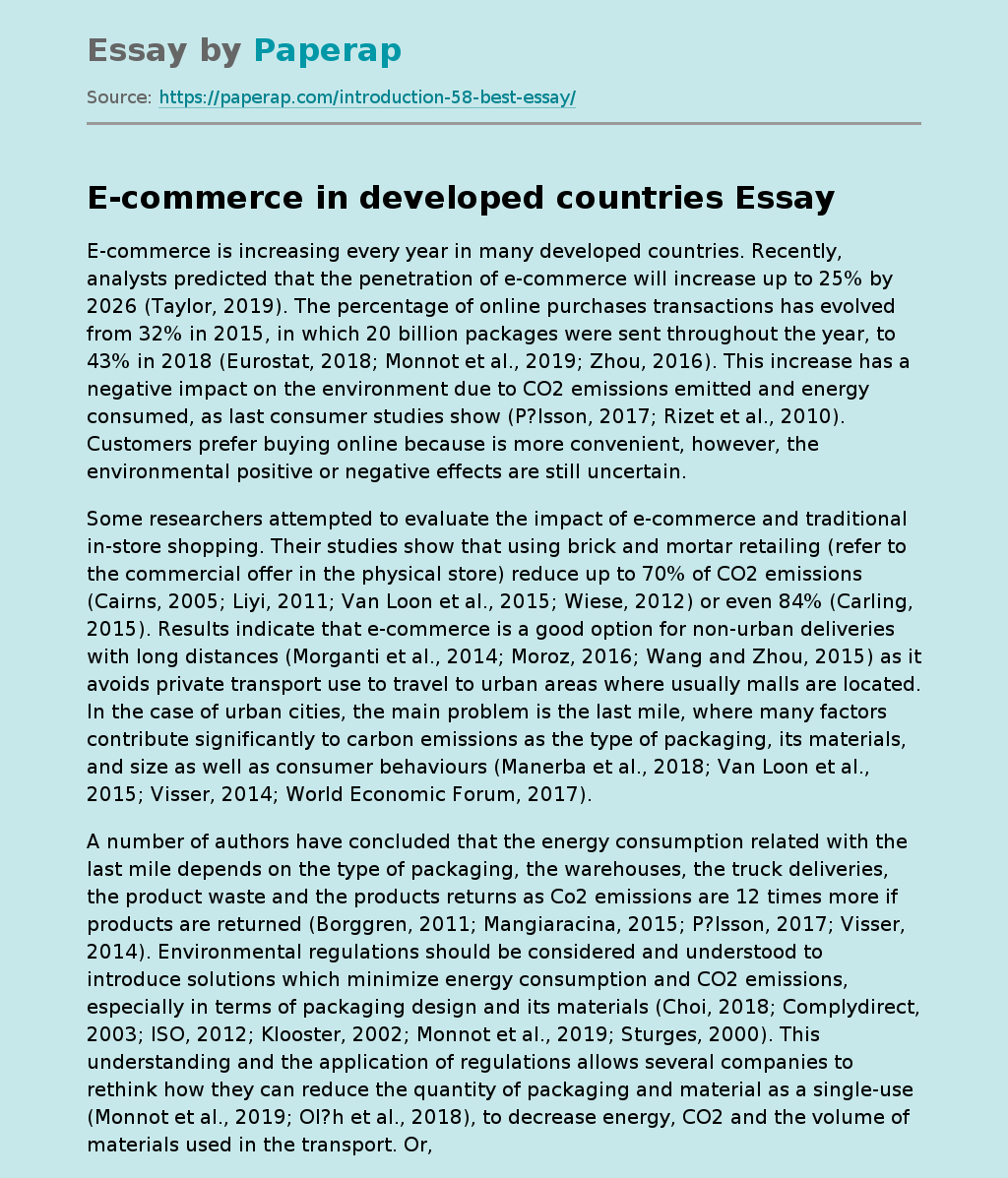E-commerce Is Increasing Every Year in Many Developed Countries
Recently, analysts predicted that the penetration of e-commerce will increase up to 25% by 2026 (Taylor, 2019). The percentage of online purchases transactions has evolved from 32% in 2015, in which 20 billion packages were sent throughout the year, to 43% in 2018 (Eurostat, 2018; Monnot et al., 2019; Zhou, 2016). This increase has a negative impact on the environment due to CO2 emissions emitted and energy consumed, as last consumer studies show (P?lsson, 2017; Rizet et al., 2010). Customers prefer buying online because is more convenient, however, the environmental positive or negative effects are still uncertain.
Some researchers attempted to evaluate the impact of e-commerce and traditional in-store shopping. Their studies show that using brick and mortar retailing (refer to the commercial offer in the physical store) reduce up to 70% of CO2 emissions (Cairns, 2005; Liyi, 2011; Van Loon et al., 2015; Wiese, 2012) or even 84% (Carling, 2015). Results indicate that e-commerce is a good option for non-urban deliveries with long distances (Morganti et al., 2014; Moroz, 2016; Wang and Zhou, 2015) as it avoids private transport use to travel to urban areas where usually malls are located.
In the case of urban cities, the main problem is the last mile, where many factors contribute significantly to carbon emissions as the type of packaging, its materials, and size as well as consumer behaviours (Manerba et al., 2018; Van Loon et al., 2015; Visser, 2014; World Economic Forum, 2017).
A number of authors have concluded that the energy consumption related with the last mile depends on the type of packaging, the warehouses, the truck deliveries, the product waste and the products returns as Co2 emissions are 12 times more if products are returned (Borggren, 2011; Mangiaracina, 2015; P?lsson, 2017; Visser, 2014).
Environmental regulations should be considered and understood to introduce solutions which minimize energy consumption and CO2 emissions, especially in terms of packaging design and its materials . This understanding and the application of regulations allows several companies to rethink how they can reduce the quantity of packaging and material as a single-use, to decrease energy, CO2 and the volume of materials used in the transport. Or, how to find the way that packaging has to be recovered, reused, and recycled in order to be more sustainable.
There is increasing concern about the importance of the packaging material as an indirect effect of the energy consumption that affects logistics and the waste that it produces . In we can see the high rate of energy to manufacture the packaging for one persons weekly consumption of food. It is 10% of the supply chain energy (Kooijman, 2009). It should not be disregarded the weight and volume of the packaging as it can affect transport energy consumption as well.
Overall, these studies highlight the need to analyse and understand alternative material packaging solution to guarantee more energy savings and waste solutions. The problem of overpackaging is also another variable to consider which affects the use of materials and the energy consumption, with consequences in the production process and transportation (Monnot et al., 2019)
We should also consider that at the last step of e-commerce, the customer has a high expectation on the service (Elgaaied-Gambier et al., 2018; Yu, 2016). 71% of customers would like to repeat the experience in online shopping if they get a premium packaging (Garc?a et al., 2019). Companies should improve consumer experience through a functional and aesthetic presentation of each package and keep the good brand image for clients. It also should be taken into account the control of the direct environmental impact and indirect packing through green messages (Tu et al., 2018). This case has shown that 67.75% of manufacturers has not the correct information related with recycling labels.
Furthermore, 98% are false labels or greenwashing practices, deceiving the customers (Choice, 2010). Other authors (Breugelmans, 2007; Monnot et al., 2019) discuss about the change in online consumer behaviour, giving less importance to the visual graphics of a product. Consequently, marketing mix strategies also change, especially those of communication and advertising. Accordingly, it is necessary to consider the importance of product information and other consumers opinions that must be generated on the website before placing the order. This change allows having almost all information on online products and less on physical products. Therefore designers and manufacturers are able to reduce packaging material.
The aim of this study is to analyse the historical evolution of the packaging, define e-commerce state of the art and understand the main environmental impact derived from e-commerce. This procedure will allow us to understand the problems associated with them and propose possible future lines of research that minimize the environmental impact of both packaging and e-commerce.
E-commerce Is Increasing Every Year in Many Developed Countries. (2019, Dec 19). Retrieved from https://paperap.com/introduction-58-best-essay/

